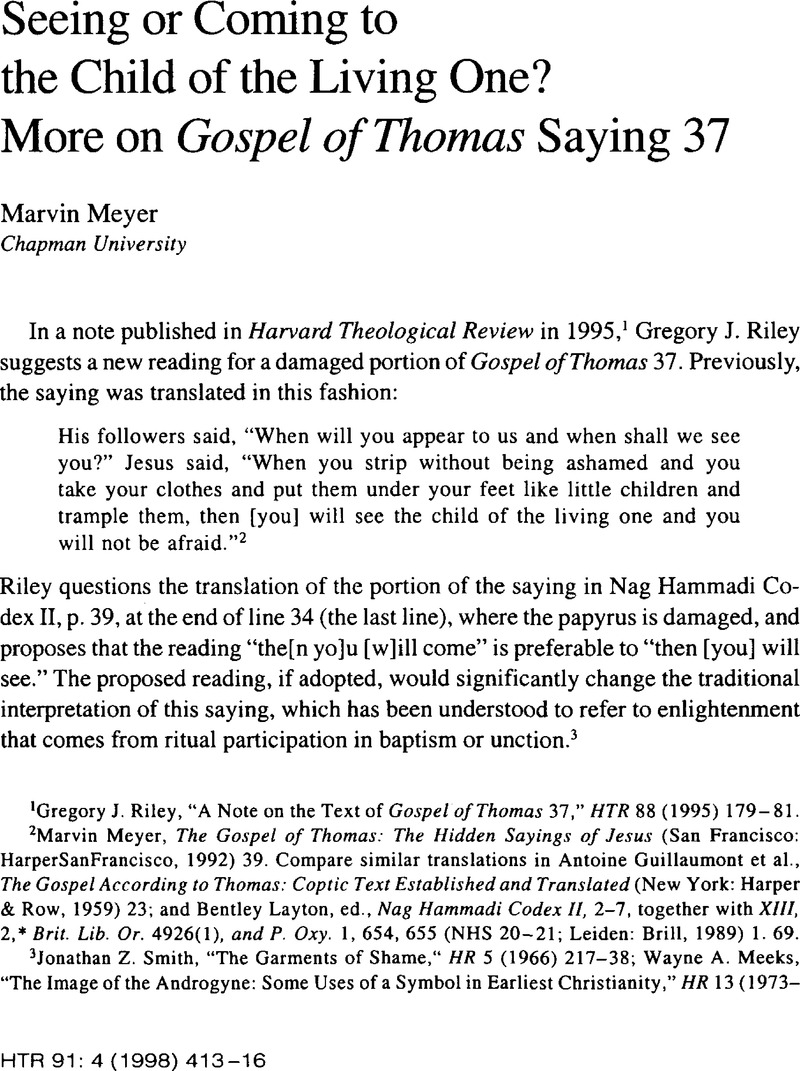No CrossRef data available.
Published online by Cambridge University Press: 10 June 2011

1 Riley, Gregory J., “A Note on the Text of Gospel of Thomas 37,” HTR 88 (1995) 179–81.CrossRefGoogle Scholar
2 Meyer, Marvin, The Gospel of Thomas: The Hidden Sayings of Jesus (San Francisco: HarperSanFrancisco, 1992) 39.Google Scholar Compare similar translations in Antoine Guillaumont et al., The Gospel According to Thomas: Coptic Text Established and Translated (New York: Harper & Row, 1959) 23Google Scholar; and Bentley Layton, ed., Nag Hammadi Codex II, 2–7, together with XIII, 2,* Brit. Lib. Or. 4926(1), and P. Oxy. 1, 654, 655 (NHS 20–21; Leiden: Brill, 1989) 1. 69.Google Scholar
3 Smith, Jonathan Z., “The Garments of Shame,” HR 5 (1966) 217–38Google Scholar; Meeks, Wayne A., “The Image of the Androgyne: Some Uses of a Symbol in Earliest Christianity,” HR 13 (1973–1974) 165–208Google Scholar; MacDonald, Dennis R., There is No Male and Female: The Fate of a Dominical Saying in Paul and Gnosticism (HDR 20; Philadelphia: Fortress, 1987)Google Scholar; April D. DeConick and Jarl Fossum, “Stripped Before God: A New Interpretation of Logion 37 in the Gospel of Thomas,” VC 45 (1991) 125–50.Google Scholar
4 The Facsimile Edition of the Nag Hammadi Codices: Codex II (Leiden: Brill [Department of Antiquities of the Arab Republic of Egypt, with UNESCO], 1974)Google Scholar pl. 49. In a footnote, Riley also states that he examined microfilm at the Institute for Antiquity and Christianity, Claremont Graduate University, but it should be noted that the microfilm in question is of poor quality, and hence not particularly helpful. The Greek fragments of the Gospel of Thomas preserved in the Oxyrhynchus Papyri cannot help with regard to saying 37, since Papyrus Oxyrhynchus 655 breaks off before the line in question.
5 Layton, Nag Hammadi: Codex II, 1. 68; Meyer, Gospel of Thomas, 38.
6 I thank Madame Samiha Abd El-Shaheed, General Director of the Coptic Museum, and the staff of the Museum for allowing me access to the Coptic manuscript of the Gospel of Thomas.
7 The Facsimile Edition of the Nag Hammadi Codices: Codex II, xvii.
8 I have not yet been able to find out whether the collotype plates on which Brashler worked are still in existence and are available for examination.
9 Layton, , “Bulletin: Gnosticisme,” RB 83 (1976) 459.Google Scholar
10 Compare also the discussion in Meyer, , The Letter of Peter to Philip: Text, Translation, and Commentary (SBLDS 53; Atlanta: Scholars Press, 1981) 79.Google Scholar